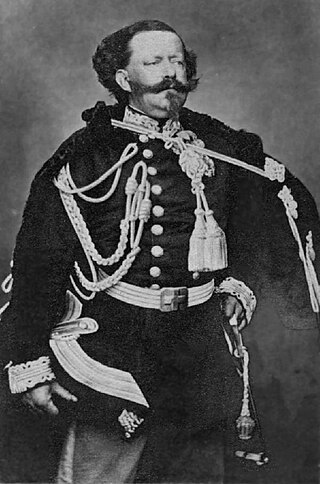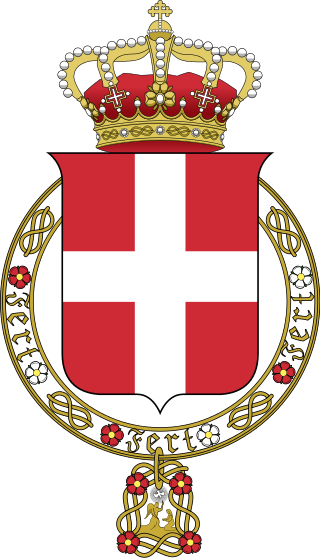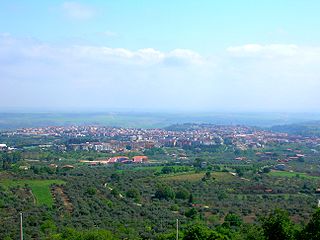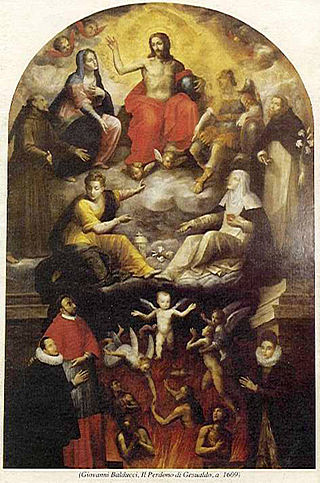
Victor Emmanuel II was King of Sardinia from 23 March 1849 until 17 March 1861, when he assumed the title of King of Italy and became the first king of an independent, united Italy since the 6th century, a title he held until his death in 1878. Borrowing from the old Latin title Pater Patriae of the Roman emperors, the Italians gave him the epithet of Father of the Fatherland.

The House of Savoy is an Italian royal house that was established in 1003 in the historical Savoy region. Through gradual expansions the family grew in power, first ruling a small Alpine county northwest of Italy and later gaining absolute rule of the Kingdom of Sicily. During the years 1713 to 1720, they were handed the island of Sardinia and would exercise direct rule from then onward.

Carlo Gesualdo da Venosa was an Italian nobleman and composer. Though both the Prince of Venosa and Count of Conza, he is better known for writing madrigals and pieces of sacred music that use a chromatic language not heard again until the late 19th century. He is also known for killing his first wife and her aristocratic lover upon finding them in flagrante delicto.

Venosa is a town and comune in the province of Potenza, in the southern Italian region of Basilicata, in the Vulture area. It is bounded by the comuni of Barile, Ginestra, Lavello, Maschito, Montemilone, Palazzo San Gervasio, Rapolla and Spinazzola. It is one of I Borghi più belli d'Italia.
The count of Vermandois was the ruler of the county of Vermandois.

Maria Vittoria Carlotta Enrichetta Giovanna dal Pozzo, 6th Princess of Cisterna d'Asti and of Belriguardo, was an Italian noblewoman who was Queen of Spain from 16 November 1870 until 11 February 1873 as the wife of King Amadeo I. Maria Vittoria inherited her princely title after the death of her father. In 1867, she married Amadeo, then Duke of Aosta, second son of King Victor Emmanuel II of Italy. In 1870, her husband became the king of Spain, making her queen consort. King Amadeo abdicated after a reign of less than three years, and he and Maria Vittoria returned to Italy. She died in Sanremo, Italy, in 1876.

A crown-cardinal was a cardinal protector of a Roman Catholic nation, nominated or funded by a Catholic monarch to serve as their representative within the College of Cardinals and, on occasion, to exercise the right claimed by some monarchs to veto a candidate for election to the papacy. More generally, the term may refer to any cardinal significant as a secular statesman or elevated at the request of a monarch.

The House of Ruspoli is historically one of the great aristocratic families of Rome, but is originally from Florence. Following World War II and the fall of Fascism, the newly established Italian Republic officially abolished titles and hereditary honours in its 1946 Constitution, with the exception of the papal nobility of Rome, as those titles had been created by papal authority.

The Archdiocese of Sant’Angelo dei Lombardi–Conza–Nusco–Bisaccia is a Latin archdiocese of the Catholic Church in Campania. It has existed since 1986. It is a suffragan of the archdiocese of Benevento.
The Catholic Diocese of Rapolla, in Basilicata, existed from the eleventh century until 1528. In that year it was united with the diocese of Melfi, to form the diocese of Melfi e Rapolla. The diocese was suppressed in 1986.

The House of Tocco was an Italian noble family from Benevento that came to prominence in the late 14th and 15th centuries, when they ruled various territories in western Greece as Counts Palatine of Cephalonia and Zakynthos and Despots of Epirus. During their brief period of rule in Greece, they were one of the most ambitious and able Latin dynasties in the region, and they were one of the few to leave descendants lasting until modern times.

Countess Louise de Mérode was a member of the House of Merode by birth and Princess della Cisterna by marriage.

The House of Khevenhüller is an old and prominent Austrian noble family, documented in Carinthia since 1356, with its ancestral seat at Landskron Castle. In the 16th century, the family split into the two branches of Khevenhüller-Frankenburg, Imperial Counts from 1593, and Khevenhüller-Hochosterwitz, raised to Imperial Counts in 1725 and, as Khevenhüller-Metsch, to princely rank (Fürsten) in 1763. The family was mediatised therefor belongs to high nobility.

Carafa or Caraffa is the name of an old and influential Neapolitan aristocratic family of Italian nobles, clergy, and men of arts, known from the 12th century.

Count of Boulogne was a historical title in the Kingdom of France. The city of Boulogne-sur-Mer became the centre of the county of Boulogne during the ninth century. Little is known of the early counts, but the first holder of the title is recorded in the 11th century.

Il Perdono di Gesualdo is an altarpiece created in 1609 by the Florentine painter Giovanni Balducci for a commission from the madrigal composer Carlo Gesualdo, Prince of Venosa, of the kingdom of Naples. Conserved in the private chapel of Gesualdo's church, Santa Maria delle Grazie, the painting underwent important restorations in the late twentieth century, following the destructive Irpinia earthquake of 1980.
Don Carlo II di Tocco Cantelmo Stuart, or Carlo di Tocco for short, was an 18th/19th-century Italian noble, serving as the Prince of Montemiletto and the titular Prince of Achaea, among other titles, from the death of his father Restaino di Tocco Cantelmo Stuart in 1796 to his own death in 1823. In addition to holding various fiefs throughout Italy, Carlo also rose to prominent positions within the Kingdom of Naples and its successor state, the Kingdom of the Two Sicilies. In 1808, he came one of the earliest knights of the Royal Order of the Two-Sicilies and from 1821 to 1823, he served as a Councillor of State in the Kingdom of the Two Sicilies.

The Cesi family is an Italian noble family which belonged to the high aristocracy of Rome and the Papal States.
The House of Dentice is an old Italian noble family, whose members occupied many important ecclesiastical and political positions.














